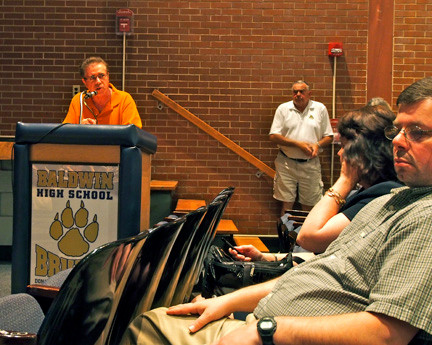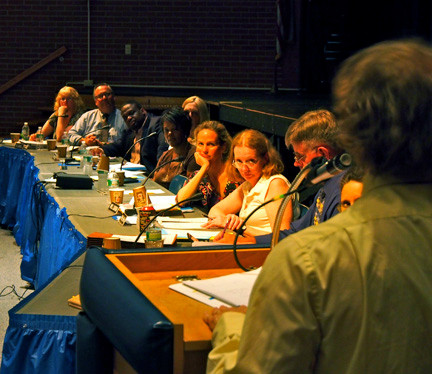Turning ‘no’ into ‘yes’
Tax levy increase scaled back to 3.14 percent for school budget revote
Faced with floating a risky schools budget with a tax levy increase of 4.1 percent, or a safer one, at 3.14 percent, the Board of Education took the path of least resistance at a public forum last Friday night. Trustees’ 4-1 decision angered many of the approximately 200 community members in attendance, and more than one person threatened to move out of Baldwin as a result.
Because the school district’s first budget proposal — which contained a tax levy increase of 7 percent — failed on May 21 despite 55.8 percent approval, the board needed to reduce the tax increase for the revote on June 18. And because the state tax cap law required the approval of a 60 percent supermajority of voters for any increase over 3.14 percent, trustees faced a difficult decision: Pierce the cap once more to try for the funding they believe they need, or stay below the cap and settle for the almost sure thing of a simple majority.
Raising the stakes in the second round of decision making is the fact that should a second budget proposal be rejected, the district will automatically revert to a contingency budget, with no increases in spending over the current budget. During the budget-building process, administrators equated this scenario to a loss of $9 million, and Trustee Laura Curran, speaking at Friday’s session, referred to it as “Armageddon.”
Building budget #2
The school board and Baldwin’s school superintendents (whose salaries have been a major sticking point with “no” voters) hosted two public meetings last week to iron out the details of a new proposal, and discussion on Thursday and Friday boiled down to two options: a spending plan with a tax levy increase of 4.1 percent, which might placate enough “no” voters to attract a supermajority; or one with an increase below 3.14 percent, which is virtually guaranteed to pass.
Although the difference between the two options seemed relatively small — about $800,000 in a budget that exceeds $120 million — the practical differences between them were stark. Some kindergarten services, arts and music, extracurricular activities and athletics that would be intact in the larger plan were cut or downsized in the smaller one.
Reductions common to both plans included secondary and elementary staffing (the equivalent of 27 teaching positions, said incoming Superintendent James Scannell), custodial and clerical positions, professional development courses and more. Scannell said May 31, however, that there would be no increases in class sizes under either proposal.
Community response
The May 30 session, held at the district offices, was largely informational, but on the 31st, at the high school, community members were allowed to voice their opinions. Twelve of the 17 who spoke urged the board to shoot for the 4.1 percent option, including Tracy Mahler, a candidate for school board last year and a frequent critic of the district, who said the board was “moving in the right direction.”
Kathy Perez directed her comments not only to the board, but to potential “no” voters in the audience. “At 4.1,” Perez said, “the cost is about $80 per household per year. That’s two mani/pedis, ladies. Skip them in the winter when no one sees your toes.”
Some of the most beguiling pleas came from students, past and present. Joseph Marchese-Schmidt, who graduated from Baldwin High School last year and now attends the University of Virginia, said he narrowly missed being admitted to Harvard. Marchese-Schmidt suggested that a few more extracurricular activities could have tipped the balance in his favor, and that an underfunded Baldwin school system would disadvantage his successors even more.

 49.0°,
Overcast
49.0°,
Overcast 











